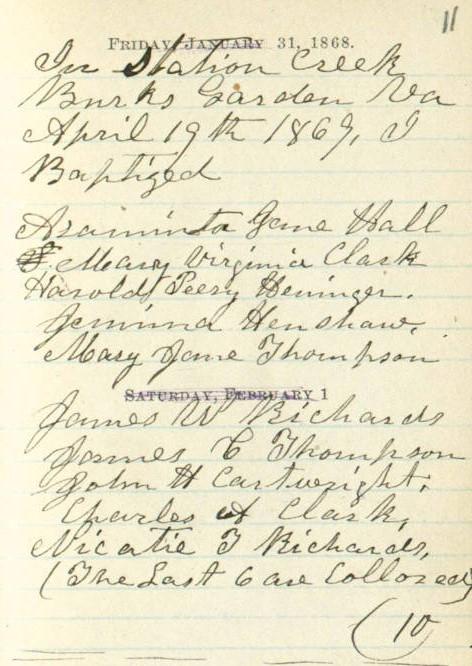Richards, Nicatie T.
Biography
On 19 April 1869, LDS missionary Henry Green Boyle from Payson, Utah, recorded in his journal ten baptisms which took place in southern Virginia:
“Held a meeting today on the banks of Station Creek where I baptized Araminta Jane Hall, Mary Virginia Clark, Harold Peery Heninger, Jemima Hanshaw and six collered folks or negroes, ten in all.”[1]
Boyle listed the full names of his white converts, including middle names, but merely lumped together his six Black proselytes as “collered folks or negroes.” Fortunately, Boyle also kept a running list of the people he baptized over the course of his mission at the front of his 1867 journal. In that entry he wrote:
“In Station Creek Burks Garden VA April 19th 1869, I baptized Araminta Jane Hall, Mary Virginia Clark, Harold Peery Heninger, Jemima Henshaw, Mary Jane Thompson, James W. Richards, James C. Thompson, John H. Cartwright, Charles A. Clark, Nicatie T. Richards. (The Last 6 are Collored).”[2]
At least here Boyle notes the full names of the six Black converts. Unfortunately, he only records their names and nothing more. There is no other identifying information, such as age, parentage, birthdate, or place of residence as is typical for Latter-day Saint baptismal records. Without additional information, it is impossible to be certain who five of the six converts were. Up to this point, only Charles A. Clark has been further identified in archival records, while Nicatie T. Richards' identity remains a mystery.
In 1860, Burkes Garden, an unincorporated community in Tazewell County, had about 800 residents who lived in 110 households. Five families owned forty percent of the land, while forty-five percent of the residents were landless. Although enslavement was relatively uncommon in southwest Virginia, many large landowners in Burkes Garden did enslave Black people. In fact, Tazewell County counted 1,192 enslaved individuals and 223 enslavers, along with approximately ninety free people of color. Most of the free Black residents were related to or worked for white households.[3] Enslaved people, in contrast, worked in the fields, made shoes, harvested sugar, delivered messages, and mined for natural resources.[4]
By 1870, the county's African American and mixed-race population had risen to 1,584, with 387 Black people living in Clear Fork, the census district that includes Burkes Garden.[5] Station Spring Creek, where Boyle performed the baptisms, is a small mountain stream roughly four miles from Burke’s Garden. It is a remote area along the Virginia/West Virginia border, the same region where Boyle grew up and lived before joining the Latter-day Saints. In the twenty-first century, Burkes Garden remains a small, rural, and remote community with around 300 residents.
Given the Black population of Tazewell County in the nineteenth century, the Nicatie J. Richards who Boyle baptized remains unknown. A search of the 1870 census, the first after emancipation, yielded no potential matches in Tazewell County, nor the state of Virginia. Thus, without further information, it is impossible to determine which Nicatie received baptism into the Church of Jesus Christ of Latter-day Saints.[6]
Nicatie likely grew up in the remote area of Burkes Garden. As an African American woman in the post-Civil War South, her life would have been marked by the profound changes that emancipation unleashed. She might have worked alongside her family in agricultural labor or domestic service, striving to build a new life for herself amidst the challenges that the Reconstruction era ushered in, especially as the United States struggled to integrate newly freed Black people into the nation’s political, economic, and social fabric.[7]
There is no indication as to what Nicatie’s religious experience may have entailed following her baptism, but this moment of faith likely influenced her life. Boyle left Virginia by the end of 1869 and took with him those converts who were willing to migrate to Utah Territory. None of the Black converts are known to have followed. Those who remained behind were left on their own for worship and organizational structure. When missionaries returned to the area in the 1880s the records they created do not offer clues as to the identities of the six Black people Boyle baptized nor do they indicate that the new missionaries were aware of Boyle’s six baptisms over a decade earlier.[8] Thus, five of the six Black converts from 1869 remain known only by their names and also by their faith—until more information becomes available.
By Sarah Day
[1] Henry Green Boyle, diary, vol. 6, 1869, p. 78, MSS 156, L. Tom Perry Special Collections, Harold B. Lee Library. Brigham Young University, Provo, Utah.
[2] Henry Green Boyle, diary, vol. 05, 1867-1868, p. 11, MSS 156, L. Tom Perry Special Collections, Harold B. Lee Library, Brigham Young University, Provo, Utah.
[3] Black in Appalachia, “Free People of Color, Tazewell County, Virginia: 1860,” Black in Appalachia: Community History Digital Archive, accessed July 10, 2024.
Black in Appalachia, “Slave Schedule, Tazewell County, Virginia: 1860,” Black in Appalachia: Community History Digital Archive, accessed July 10, 2024.
[4] Ralph Mann, “Mountains, Land, and Kin Networks: Burkes Garden, Virginia, in the 1840s and 1850s,” The Journal of Southern History 58, no. 3 (1992): 411–34.
[5] Black in Appalachia, “Black & Mulatto Families, Tazewell County, Virginia: 1870,” Black in Appalachia: Community History Digital Archive, accessed July 10, 2024.
[6] United States, 1870 Census, Virginia, Tazewell County.
[7] Eric Foner, A Short History of Reconstruction, 1863-1877 (New York: Harper and Row, 1990); W. Caleb McDaniel, Sweet Taste of Liberty: A True Story of Slavery and Restitution in America (New York: Oxford University Press 2019).
[8] Boyle diary, vol. 7, 1869-1870; Church of Jesus Christ of Latter-day Saints, Record of Members Collection, North Carolina Conference, CR 375 8, box 4727, folder 1, image 115, Church History Library, Church of Jesus Christ of Latter-day Saints, Salt Lake City, Utah; Heather Seferovich, “History of the LDS Southern States Mission, 1875-1898,” Master’s thesis, Brigham Young University, Provo, Utah, 1996.
Documents
Click the index tab in the viewer above to view all primary source documents available for this person.


